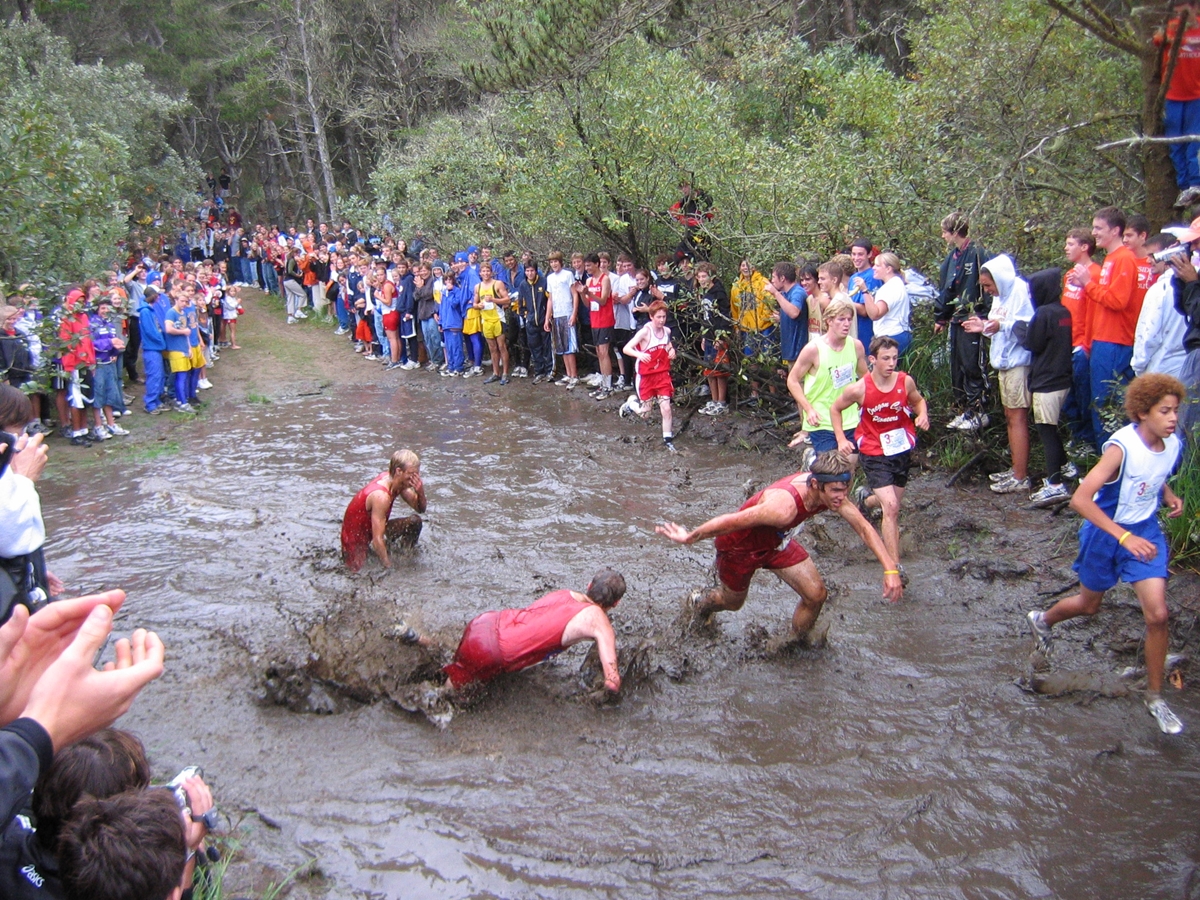

Featured
How To Run Hills Cross Country
Modified: January 2, 2024
Learn how to master hill workouts in cross country with our featured guide, packed with tips and techniques to help you conquer any terrain.
Introduction
Hill running is a crucial component of cross country training, providing numerous benefits that can greatly enhance performance. Whether you’re an experienced cross country athlete or just starting out, incorporating hill running into your training regimen can take your running ability to the next level. Running uphill not only strengthens your muscles, but also improves your cardiovascular endurance, speed, and overall running efficiency.
In this article, we will explore the various benefits of hill running in cross country, discuss how to properly prepare for hill running, and provide valuable tips on technique, training strategies, safety, and nutrition. Whether you’re training for a cross country race or simply looking to improve your fitness, this guide will equip you with the knowledge and tools to conquer hills with confidence.
Before diving into the specifics of hill running, it’s important to understand the physiological and psychological benefits it offers. Running uphill engages different muscle groups and increases the intensity of your workout, helping to build strength and endurance. The incline also challenges your cardiovascular system, forcing your heart and lungs to work harder, ultimately improving your overall aerobic capacity. Additionally, hill running can boost your mental fortitude, as conquering challenging terrain builds resilience and mental toughness.
As you continue reading, you’ll discover the importance of proper preparation for hill running, including a gradual increase in mileage and incorporating strength training exercises to strengthen key muscles. We’ll also delve into the correct technique for running uphill, focusing on maintaining good posture, utilizing the arms effectively, and adopting the right stride length and foot placement for maximum efficiency.
Furthermore, this article will provide you with various training strategies to implement in your hill running routine. These strategies include hill repeats, tempo runs on hilly terrain, and incorporating hill sprints into your workouts. Each strategy aims to improve your strength, speed, and endurance specifically for hill running, allowing you to tackle even the steepest of inclines with confidence.
It’s important to note that safety and injury prevention are fundamental aspects of hill running. We will discuss the importance of warming up properly before a hill workout, wearing the right gear to ensure stability, and listening to your body to prevent overuse injuries. Additionally, we’ll address the role of nutrition in supporting your hill running training, as proper fueling and hydration are key to optimize performance and aid in recovery.
By the end of this article, you will have a comprehensive understanding of the benefits of hill running, the necessary preparations and techniques, training strategies, safety measures, and nutritional considerations. Whether you’re tackling a challenging cross country course or want to improve your overall running ability, incorporating hill running into your training routine will undoubtedly elevate your performance, making you a stronger and more resilient runner.
Benefits of Hill Running in Cross Country
Hill running is a fundamental aspect of cross country training, offering a wide range of benefits that can significantly enhance overall performance. Let’s explore some of the key advantages of incorporating hill running into your training regimen.
1. Strengthens Muscles: Running uphill engages your lower body muscles, including your quadriceps, hamstrings, glutes, and calves, in a way that flat terrain cannot. The constant uphill motion forces these muscles to work harder, building strength, power, and endurance. This increased muscular strength translates to improved performance on other terrains as well.
2. Improves Cardiovascular Endurance: Hill running challenges your cardiovascular system by increasing the demand for oxygen-rich blood to your working muscles. As you ascend the incline, your heart rate elevates, and your lungs must work harder to deliver oxygen to your muscles. Over time, this improves your aerobic capacity, allowing you to sustain higher intensity efforts for longer durations.
3. Enhances Speed and Power: Running uphill demands more power and explosive force with each stride. It requires a greater recruitment of fast-twitch muscle fibers, which are crucial for generating speed. Regular hill running can improve your stride turnover and increase your sprinting ability, making you a faster and more powerful runner overall.
4. Develops Running Efficiency: Proper form is essential when running uphill, as it helps maintain momentum and energy efficiency. Uphill running promotes a shorter, quicker stride and a slightly forward lean, which enables you to make the most of each stride. By focusing on maintaining good posture and utilizing your arm swing effectively, you will develop better running mechanics that can transfer to flatter terrains as well.
5. Builds Mental Toughness: Conquering hills requires mental resilience and determination. Running uphill pushes you out of your comfort zone and challenges you both physically and mentally. As you tackle challenging inclines, you develop mental toughness, grit, and discipline, which can be valuable assets not only in running but in other areas of life as well.
6. Variation in Training Intensity: Incorporating hills into your training adds variety and increases the overall intensity of your workouts. This variation helps prevent monotony and keeps your body constantly adapting, leading to continued improvements in your fitness level.
7. Simulates Race Conditions: Many cross country courses include hilly sections, and hill running allows you to simulate race conditions during training. By familiarizing yourself with uphill running, you can strategize and prepare for the demands of a racecourse, giving you a competitive edge when it matters most.
8. Increased Calorie Burn: Running uphill requires greater effort and energy expenditure compared to running on flat surfaces. This increased energy demand translates to more calories burned during your workouts, aiding in weight management and overall fitness.
Overall, hill running offers a multitude of benefits that can significantly improve your performance in cross country. By incorporating regular hill workouts into your training routine, you’ll strengthen muscles, improve cardiovascular endurance, enhance speed and power, develop running efficiency, build mental toughness, vary training intensity, simulate race conditions, and increase calorie burn. These benefits make hill running a valuable component of any cross country training program.
Preparing for Hill Running
Proper preparation is essential before embarking on hill running in order to reduce the risk of injuries and maximize the benefits of your workouts. Here are some key considerations to help you prepare for hill running:
1. Gradual Increase in Mileage: If you’re new to hill running or haven’t incorporated hills into your training before, it’s important to gradually introduce them into your routine. Start by adding one hill workout per week and gradually increase the frequency and duration as your body adapts. This gradual progression will help prevent overuse injuries and allow your muscles and cardiovascular system to adjust to the increased demands of uphill running.
2. Strengthen the Key Muscles: Running uphill places a greater demand on specific muscle groups, so it’s important to strengthen these areas to ensure optimal performance and reduce the risk of injury. Focus on exercises that target the quads, hamstrings, glutes, and calves. Squats, lunges, calf raises, and step-ups are all effective exercises to include in your strength training routine.
3. Warm Up Properly: Before starting a hill running workout, it’s crucial to warm up your muscles and increase your heart rate. Perform dynamic stretches and light jogging to activate your muscles and get the blood flowing. This prepares your body for the upcoming workout and reduces the chance of muscle strains or pulls.
4. Choose the Right Footwear: Wearing proper running shoes with adequate support and traction is crucial for hill running. Look for shoes that provide stability and have a grippy outsole to ensure good traction on uneven terrain. Consider visiting a specialty running store to get fitted for the right shoes based on your foot type and running style.
5. Find Suitable Terrain: When starting out with hill running, look for moderate hills with a gradual incline. This allows your body to adapt to the demands of uphill running without placing excessive stress on your muscles and joints. As you gain more experience and strength, gradually increase the intensity of the hills you tackle.
6. Incorporate Hill Repeats: Hill repeats are an effective way to build strength and endurance for hill running. Start with shorter hill repeats, such as 30 seconds to 1 minute of uphill running, followed by an easy jog or walk downhill to recover. Gradually increase the duration of the repeats as you become more comfortable and stronger.
7. Listen to Your Body: Pay attention to how your body feels during and after hill running workouts. If you experience any pain or discomfort, it’s important to address it promptly. Rest, ice, and elevate any sore areas and consider seeking guidance from a healthcare professional if necessary. Pushing through pain can lead to more serious injuries and derail your training progress.
By following these preparation tips, you’ll be well-equipped to tackle hill running with confidence and minimize the risk of injuries. Remember to gradually increase your mileage, strengthen key muscles, warm up properly, choose the right footwear, find suitable terrain, incorporate hill repeats, and listen to your body. With proper preparation, you’ll be able to reap the full benefits of hill running and take your cross country performance to new heights.
Proper Technique for Hill Running
Hill running requires a slightly different technique compared to running on flat terrain. Mastering the proper technique for hill running is crucial to maximize your efficiency and reduce the risk of injuries. Here are some key tips to help you develop and maintain good form while running uphill:
1. Maintain Good Posture: Keep your posture upright and tall while running uphill. Avoid leaning too far forward or bending at the waist, as this can put unnecessary strain on your lower back and hamper your breathing. Engage your core muscles to support a strong and stable posture throughout your hill running workouts.
2. Utilize Arm Swing: Your arms play an essential role in hill running. Keep your arms bent at approximately 90 degrees and swing them naturally back and forth in sync with your stride. As you ascend the hill, pump your arms more vigorously to generate additional propulsion and help drive your legs forward.
3. Shorten Your Stride: When running uphill, it’s crucial to shorten your stride length. Taking shorter, quicker steps allows for greater agility, improves your power and efficiency, and helps maintain momentum. Focus on taking quick turnover strides rather than overreaching with each step.
4. Use Your Toe-Off: Push off from your toes with each step as you ascend the hill. This engages your calves and aids in propelling you forward, utilizing the natural spring-like mechanism of your foot. Avoid relying solely on your quads for power, as this can lead to muscle fatigue.
5. Adapt Your Breathing: Adjust your breathing pattern to accommodate the increased effort of running uphill. Take deeper breaths to ensure an adequate supply of oxygen to your working muscles. If needed, implement a rhythmic breathing pattern, such as inhaling for three steps and exhaling for three steps, to help regulate your breathing and enhance your performance.
6. Focus on Cadence: Aim for a slightly higher cadence when running uphill. Increasing your turnover rate helps to offset the reduced stride length and allows you to maintain a consistent pace. Pay attention to your foot turnover and strive for a fast but controlled rhythm throughout your hill running workouts.
7. Gradual Descent: When descending from a hill, be mindful of your technique to reduce the risk of injury. Bend your knees slightly and lean forward slightly to maintain your balance and control your speed. Avoid braking or leaning too far back, as this can put excessive stress on your knees and lead to instability.
Practicing these proper techniques will improve your efficiency, speed, and overall performance while running uphill. Remember to maintain good posture, utilize arm swing, shorten your stride, use your toe-off effectively, adapt your breathing, focus on cadence, and be mindful of your technique during descents. With consistent practice and attention to form, you’ll become a more proficient and confident hill runner.
Training Strategies for Hill Running
When it comes to hill running, incorporating effective training strategies into your routine is key to improving your strength, endurance, and overall performance. Here are some training strategies to help you maximize the benefits of hill running:
1. Hill Repeats: Hill repeats are a popular and effective training method for hill running. Find a hill with a moderate incline and run up at a challenging but sustainable effort. Then, jog or walk back down to recover. Repeat this interval multiple times, gradually increasing the number of repeats as you progress. Hill repeats help build strength and power specific to uphill running, while also enhancing your aerobic capacity.
2. Tempo Runs on Hilly Terrain: Incorporating tempo runs on hilly terrain helps improve your endurance and ability to sustain a faster pace on uphill sections. During a tempo run, maintain a comfortably hard effort level as you tackle rolling hills or a steady incline. This type of training helps simulate race conditions and builds stamina for steeper climbs.
3. Hill Sprints: Hill sprints are short, intense bursts of effort that target speed and power. Find a steep hill and sprint up at maximum effort for a short distance, such as 30 to 60 meters. Walk or jog back down to recover before repeating. Hill sprints develop explosive muscle power, improve your stride turnover, and enhance your ability to handle steep inclines.
4. Long Hill Runs: Incorporating long runs that include significant uphill sections is an effective way to build endurance and mental toughness. Seek out longer routes that include sustained uphill segments or multiple hills. These runs will challenge your aerobic capacity while simulating the demands of racecourses with hills.
5. Downhill Training: Don’t overlook the importance of downhill training to prepare for the descents in hilly races. Including downhill segments in your training runs helps strengthen the eccentric muscle contractions involved in absorbing impact and controlling your speed on descents. Gradually increase the intensity and duration of downhill segments to build strength and improve your downhill running technique.
6. Cross-Training: Incorporating cross-training activities such as cycling, stair-climbing, or using an elliptical machine can complement your hill running workouts. These activities provide a low-impact yet effective way to build cardiorespiratory endurance and lower body strength, which are essential for hill running.
7. Periodization: Implement a periodization plan by varying the intensity and volume of your hill running workouts over the course of your training cycle. This structured approach helps prevent overtraining, allows for proper recovery, and ensures continuous improvement. Gradually increase the difficulty and duration of your hill workouts, while also incorporating recovery days and lighter training weeks to prevent burnout and reduce the risk of injury.
8. Mental Preparation: Hill running can be mentally challenging, so it’s important to build mental resilience. Visualize yourself conquering hills with ease, practice positive self-talk, and set realistic goals for your hill running workouts. Building mental strength and confidence will help you push through discomfort and navigate challenging racecourses more effectively.
By incorporating these training strategies into your hill running routine, you’ll build the necessary strength, speed, endurance, and mental toughness to tackle even the most challenging hills. Remember to mix up your training with hill repeats, tempo runs, hill sprints, long hill runs, downhill training, cross-training, and proper periodization. Consistency and dedication to these strategies will significantly enhance your hill running performance over time.
Safety and Injury Prevention for Hill Running
Hill running, while incredibly beneficial for your fitness and performance, can also pose certain risks if not approached with caution. Prioritizing safety and injury prevention is vital to ensure you can continue to enjoy the benefits of hill running. Here are some essential tips to keep in mind:
1. Warm Up Properly: Before starting your hill running workout, warm up your muscles with dynamic stretches and light jogging. This pre-run warm-up increases blood flow to your muscles, improves flexibility, and reduces the risk of strains or pulls.
2. Wear Appropriate Gear: Select the right running shoes with good traction to provide stability and support on varying terrains. Consider investing in trail running shoes that offer extra grip for challenging uphill and downhill sections. Additionally, wear moisture-wicking clothing to stay comfortable and prevent chafing.
3. Start with Smaller Hills: If you are new to hill running or have not tackled hilly terrain before, begin with smaller hills that have a gradual incline. This allows your body to adapt to the added demand of running uphill and reduces the risk of overuse injuries.
4. Focus on Proper Technique: Maintaining good form while running uphill is crucial to avoid injuries. Keep your posture upright, engage your core, and use your arms to assist with momentum. Shorten your stride, push off with your toes, and avoid overstriding which can lead to muscle strains or joint injuries.
5. Monitor Your Intensity: Gradually increase the intensity and duration of your hill workouts to allow your body to adapt. Listen to your body and avoid pushing too hard too soon, as this can lead to overtraining and injuries. Incorporate rest days and recovery periods to allow your muscles to repair and strengthen.
6. Be Aware of Downhill Technique: Running downhill puts strain on different muscle groups and can increase the risk of injuries if not approached carefully. Lean slightly forward, control your speed, and avoid braking or overstriding. Focus on maintaining stability and absorbing the impact with your muscles.
7. Stay Hydrated: Proper hydration is crucial for any type of running, including hill running. Drink water before and after your workouts, and consider carrying water with you on longer runs. Hydration helps regulate body temperature, supports performance, and aids in recovery.
8. Listen to Your Body: Pay attention to any pain or discomfort during or after hill running. If you experience persistent or worsening pain, be cautious and consult a healthcare professional. Ignoring pain can potentially lead to more serious injuries and prolonged recovery periods.
9. Include Strength Training: Strengthening your muscles through resistance training can provide added stability and protection against injuries. Focus on exercises that target your lower body, such as squats, lunges, and calf raises, to build strength and support your hill running endeavors.
10. Rest and Recover: Allow yourself enough time to rest and recover between hill running workouts. Adequate rest is essential for your muscles to repair, rebuild, and grow stronger. Incorporate easy running days, cross-training, and recovery techniques like foam rolling and stretching to promote proper recovery.
By following these safety and injury prevention tips, you can minimize the risks associated with hill running and enjoy the numerous benefits it offers. Remember to warm up properly, wear appropriate gear, start with smaller hills, focus on proper technique, monitor your intensity, be aware of downhill technique, stay hydrated, listen to your body, include strength training, and prioritize rest and recovery. With a mindful approach, you can maintain a safe and injury-free hill running practice.
Nutritional Considerations for Hill Running
Proper nutrition plays a vital role in supporting your hill running performance and aiding in recovery. Fueling your body with the right nutrients before, during, and after your workouts is essential to optimize your performance and enhance your overall well-being. Here are some key nutritional considerations to keep in mind for hill running:
1. Hydration: Staying properly hydrated is critical for any type of exercise, including hill running. Drink water consistently throughout the day and ensure you are well-hydrated before your workouts. During longer runs, especially in hot or humid conditions, consider carrying water or electrolyte-rich sports drinks to replenish fluids lost through sweat.
2. Carbohydrates: Carbohydrates are the primary fuel source for intense exercise, including hill running. Prioritize consuming complex carbohydrates such as whole grains, fruits, vegetables, and legumes. These foods provide sustained energy and help replenish glycogen stores in your muscles to support prolonged efforts uphill.
3. Pre-Workout Fuel: Consume a balanced meal or snack containing carbohydrates, protein, and fats about 1 to 2 hours before your hill running workouts. This will provide your body with the necessary energy to perform while avoiding discomfort during exercise. Opt for easily digestible options such as oatmeal, yogurt with fruits, or a banana with nut butter.
4. During-Training Fuel: For longer hill running workouts or races, consider consuming easily digestible carbohydrates during your run to sustain energy levels. Energy gels, sports drinks, or small snacks like energy bars or dried fruits can provide a quick source of glucose to keep you fueled and prevent glycogen depletion.
5. Post-Workout Recovery: After your hill running workouts, prioritize refueling your body to support muscle recovery and glycogen replenishment. Consume a snack or meal that includes carbohydrates and protein within 30 to 60 minutes of finishing your run. This can be a combination of a protein shake, Greek yogurt with fruits, or a balanced meal featuring lean protein with whole grains and vegetables.
6. Protein Intake: Protein is crucial for muscle repair and growth. Include a source of lean protein in each meal, such as chicken, fish, tofu, or legumes. This helps support muscle recovery, especially after intense hill running workouts that may cause muscle damage.
7. Balanced Diet: Maintain a well-rounded diet that includes a variety of fruits, vegetables, whole grains, lean proteins, and healthy fats. These foods provide essential vitamins, minerals, and antioxidants that contribute to overall health and support your body’s ability to perform optimally during hill running.
8. Listen to Your Body: Pay attention to how different foods and eating patterns impact your performance and well-being. Experiment with different pre-workout, during-training, and post-workout nutrition strategies to find what works best for you. Everyone’s nutritional needs can vary, so it’s important to listen to your body’s cues and adjust accordingly.
9. Seek Professional Advice: If you have specific dietary concerns or questions, consider consulting a registered dietitian or sports nutritionist. They can provide personalized recommendations based on your individual needs and goals.
Proper nutrition is a key component of successful hill running. Hydrate adequately, consume a balanced meal before workouts, fuel during longer runs, prioritize post-workout recovery meals, include protein in your diet, maintain a balanced diet, listen to your body, and seek professional advice when needed. By nourishing your body properly, you’ll optimize your performance, support your overall health, and enjoy the benefits of hill running to the fullest.
Conclusion
Hill running is a powerful training tool that offers numerous benefits for cross country athletes and fitness enthusiasts alike. Incorporating hill running into your training routine strengthens your muscles, improves cardiovascular endurance, enhances speed and power, develops running efficiency, builds mental toughness, and provides variation in training intensity. By gradually increasing mileage, focusing on proper technique, and implementing effective training strategies such as hill repeats and tempo runs, you can take your hill running performance to new heights.
However, it’s essential to prioritize safety and injury prevention throughout your hill running journey. Warm up adequately, wear the appropriate gear, monitor your intensity, and listen to your body to minimize the risk of injuries. Additionally, proper nutrition plays a crucial role in fueling your hill running workouts and aiding in recovery. Hydrate well, consume balanced meals with an emphasis on carbohydrates and protein, and listen to your body’s nutritional needs to optimize your performance and overall well-being.
Remember that hill running is a journey that requires consistency and patience. As you integrate hill running into your training routine, gradually progress in intensity and volume while allowing for proper rest and recovery. Your body will adapt and grow stronger over time, enabling you to conquer even the toughest hills with confidence and grace.
So lace up your running shoes, find a hilly terrain near you, and embark on the adventure of hill running. Embrace the physical and mental challenges, and enjoy the rewards of improved performance, increased endurance, and a stronger, resilient body. Whether you’re a competitive cross country athlete striving for a personal best or simply looking to add a new dimension to your fitness routine, hill running is sure to take you to new heights in your athletic journey.









